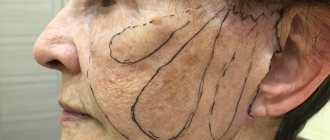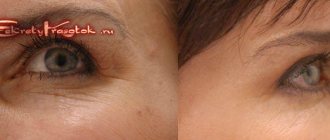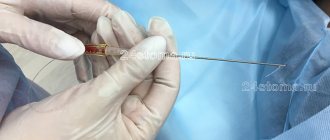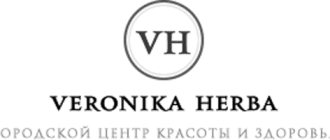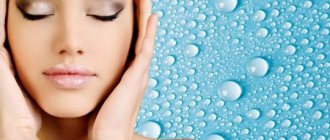In previous articles, I talked about the fact that non-surgical facelift methods have a quick recovery period. Surprisingly, many people think that there is no need for recovery after such procedures. And what’s even more surprising is that most expect results the next day.
In fact, any manipulation of your body requires subsequent recovery. And in most cases, the results do not show immediately.
Therefore, today we will talk about how the rehabilitation period goes after a circular facelift using various methods.
Rehabilitation after space facial surgery
Space facial plastic surgery (spatial face lifting according to Dr. Mendelson) is a surgical method of face lifting. However, this advanced technique does not require hospitalization or long-term observation. The rehabilitation period takes little time and is almost painless.
On average, rehabilitation takes 10-12 days.
For the first 2-3 days, the patient wears a special bandage. On the fourth day it is removed. All that remains is the need to process the seams.
Features of rehabilitation:
- It is necessary to limit physical activity for 1 month.
- It is necessary to refrain from visiting a solarium, bathhouse, or swimming pool (1 month).
- During the rehabilitation period, no special procedures are required.
- Hair washing is possible in full after removing the bandage.
Skin care after surgery
Cosmetic and hardware procedures will help to restore the skin as quickly as possible after a facelift. They can be carried out (with the exception of physiotherapy) after the main rehabilitation period has ended. The following manipulations are allowed:
- physiotherapy – microcurrents (3-4 days after surgery), ultrasound (2-3 weeks),
- lymphatic drainage, electrostatic massage – 25-30 days after surgery;
- use of professional cosmetics (peelings) – after 2-3 months;
- injection procedures (mesotherapy, plasma therapy, Botox) – after 3-5 months.
Compliance with all rules for facial skin care, compliance with medical prescriptions, and supporting procedures is the key to quick recovery and satisfaction with the result of a facelift.
Rehabilitation after SMAS lifting
Unlike space facial plastic surgery, SMAS requires a fairly long recovery.
In the first days, the doctor observes the patient in the clinic. There is always a risk of complications. Therefore, the specialist prescribes antibiotics to the patient to prevent infection. And he carefully observes the behavior of scars, swelling and bruises.
If no complications arise, the patient is sent home with a list of recommendations. Such as:
- Sleep on your back on a high pillow.
- Wear a compression bandage for 7 days.
- Treat the seams with an antiseptic 2 times a day.
- Refrain from smoking and alcohol.
- Refrain from physical activity for 1-2 months.
- Do not visit saunas, baths, swimming pools for 1-2 months.
- Do not sunbathe for six months.
Methods of facial rejuvenation by zones
Often patients do not decide to undergo a full circular facelift or do not consider such an intervention necessary. “Is it possible to rejuvenate the face by zones?” is one of the most popular questions asked to a plastic surgeon. Yes, modern techniques allow this.
Such manipulations include:
- front lifting (lifting the upper part of the face);
- check-lifting (mid-face lifting);
- S-lifting and max-lifting (lifting the lower face and neck);
- space lifting (lifting the middle and lower part of the face).
Front lifting. This aesthetic technique is used to eliminate the first signs of aging. Typically, patients aged about 40 years old with pronounced transverse wrinkles on the forehead, folds between the eyebrows, drooping eyebrows and lower eyelid resort to it.
During the operation, the surgeon tightens the tissues of the upper part of the face. After wrinkles on the forehead are smoothed out and eyebrows are raised, the patient's face becomes more youthful and open.
On our website you can learn more about forehead lift techniques.
Photo before a circular facelift
1 Photos before circular facelift
2 Photos before circular facelift
3 Photos before circular facelift
Photo after a circular facelift
1 Photos after a circular facelift
2 Photos after a circular facelift
3 Photos after a circular facelift
Check-lifting . Used to combat signs of aging in the midface such as:
- hernias (bags) under the eyes;
- sagging cheeks, “shaved”;
- pronounced nasolabial folds.
The technique helps remove small and medium wrinkles, eliminate sagging skin and swelling of the face. It is advisable to carry out check-lifting in combination with blepharoplasty, since the incisions run along the ciliary edge of the lower eyelid.
During the operation, the muscle tissue is fixed in the required position using special endotin plates (3.5-4.5 mm in size). Resorption of endotins occurs within a year, during which time connective tissue has time to form.
The intervention is performed under general anesthesia and lasts up to 1.5 hours. The result of such a lift lasts 6-7 years.
S-lifting. This operation is also called a short-scar or short-flap lift. S-lifting allows you to lift the lower part of the face, get rid of jowls and double chins, and make the lower contour of the face noticeably clearer.
The operation begins with an incision behind the ears or in front of the auricle. Next, the surgeon isolates and tightens the tissues of the SMAS layer, which are attached with hanging sutures to the periosteum of the zygomatic bone.
The advantages of the S-lift: despite its low invasiveness, it is almost as effective as the SMAS lift. Disadvantage: the technique is not suitable for older patients with pronounced wrinkles.
Max lifting . This is a variant of the S-lift, a facelift through minimal access. This technique is a kind of “compromise” between conventional rhytidectomy and SMAS lift.
During max-lifting, excess skin is excised and the deep structures of the face are tightened. The main advantage of this technique is the ability to perform a full facelift through small skin incisions.
Space lifting (or spatial lifting) . A relatively new type of facelift, a minimally invasive lift of the middle and lower parts of the face (cheekbones, cheeks, nasolabial triangle, lower jaw area, neck).
The movement of tissues during space lifting is carried out strictly along the spaces - the physiological spaces under the facial muscles in the cheek area, the area of the zygomatic bone and the lower jaw. Using endoscopic equipment, the surgeon identifies the spacers, then moves them and secures them in the desired position.
The operation is performed under intravenous anesthesia and lasts on average 2 hours. Space lifting is characterized by a short rehabilitation period (3-7 days).
Photo before a circular facelift
1 Photos before circular facelift
2 Photos before circular facelift
3 Photos before circular facelift
Photo after a circular lift
1 Photos after a circular facelift
2 Photos after a circular facelift
3 Photos after a circular facelift
Rehabilitation after hardware lifting
The recovery time after a hardware facelift depends on the chosen device and the methods of its influence.
- Photorejuvenation is exposure to directed beams of light with a certain wavelength.
Crusts form on the face and disappear completely within a few days.
Rehabilitation takes about a week.
- Radio wave lifting – exposure to high purity radio waves.
On the first day after the procedure, redness, swelling, and increased sensitivity of the skin are possible.
Some patients experience dry skin, which can be easily relieved with moisturizer.
- Laser lifting
Due to the depth of impact, the rehabilitation period is 7-14 days.
- Ultrasonic lifting
In most cases, rehabilitation takes only a couple of days. The patient can immediately carry out his usual activities if he does not feel discomfort and there are no visual manifestations of complications.
SMAS facelift for the face: technique
Plastic surgery using the SMAS technique is performed under general anesthesia, as the procedure can last up to 4 hours. The risk of complications is minimal, since new generation drugs are used for anesthesia that do not cause side effects.
During the surgical procedure, the doctor makes incisions behind the ears and on the neck. Next, the skin is peeled off to fix the tissues in the desired position. Excess skin is removed.
The depth of the incisions and their size are directly dependent on the condition of the patient’s facial skin. The stronger the tissue ptosis, the deeper the incisions will be.
In most cases, the plastic surgeon performs neck correction along with a facelift. This is necessary in order to create a smooth transition of fabrics. If this is not done, then a strong contrast will be visible. If necessary, the doctor uses liposuction to remove fatty tissue in the cheek area in order to form the correct contour.
Rehabilitation after a facelift with threads
Some experts believe that a facelift with threads is practically plastic surgery. Since the threads are inserted through small incisions.
After the procedure, minor bruising and swelling may appear. If no complications arise, they will go away in about a week.
Complete rehabilitation after thread lifting takes about a month and involves a number of restrictions:
- Sleep only on your back (2 weeks).
- Refrain from using cosmetics (up to 7 days).
- Abstinence from alcohol, smoking, heavy food (at least 2 weeks).
- Abstinence from visiting saunas and solariums (1 month).
- Prohibition of physical activity (1 month).
- Prohibition of travel to hot countries (one month after the procedure).
Contraindications for facelift
As with most surgical procedures, contraindications to a deep facelift include:
- acute inflammatory and viral diseases;
- increased body temperature;
- oncological diseases;
- diabetes;
- blood clotting disorder;
- mental disorders, epilepsy.
The most suitable age for a facelift is considered to be 45-60 years old. At a younger or older age, performing a deep facelift is inappropriate and not as effective.
Summary
As I said at the beginning of the article: any manipulation of your body requires subsequent recovery. In some cases it means a day or two of rest, in others it means several months of restrictions. It is important to remember a number of general points:
- Strictly follow the specialist's recommendations.
- Tell your specialist about anything that is causing you concern.
- Monitor your health carefully.
- Refrain from sunbathing, solariums and baths.
- Give yourself a break from physical activity.
- Don't worry if you don't see the desired changes in the mirror the next day after the procedure.

